Thursday, July 26 2018
Have you ever wondered how the average rattlesnake hunts and attacks its prey? Not human prey— most snakes are not aggressive toward people unless startled or provoked— but their usual food of frogs, lizards, mice and other rodents? Snakes are often thought of as incredibly stupid eating machines, but it turns out that the more you look at snakes, the more sophisticated their behavior becomes, according to recently published findings in the Journal of Herpetology.
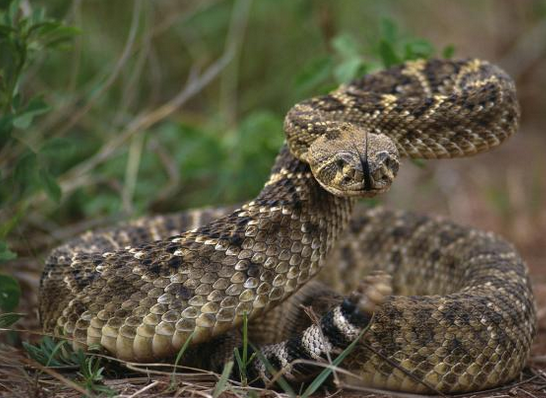 Normally, rattlesnakes rely on ambush, sitting back and waiting for the prey to come within reach before a lightning-quick strike with their fangs. Sometimes they even use their tails as bait, wiggling them slightly as a worm-like lure for creatures such as skinks that would be attracted to worms. After the initial strike, and depending on the type of prey, snakes might hang back and wait for the venom to take hold. When you think about it, this is a smart plan for vipers because their prey might attempt to strike back at them after being bitten. Normally, rattlesnakes rely on ambush, sitting back and waiting for the prey to come within reach before a lightning-quick strike with their fangs. Sometimes they even use their tails as bait, wiggling them slightly as a worm-like lure for creatures such as skinks that would be attracted to worms. After the initial strike, and depending on the type of prey, snakes might hang back and wait for the venom to take hold. When you think about it, this is a smart plan for vipers because their prey might attempt to strike back at them after being bitten.
Scientific studies provide insight into the ways venomous snakes adapt to the behavior of their dangerous prey. For example, centipedes are armed with two venom-filled front legs that often act like fangs. As you might expect, centipedes don’t exactly go through life expecting problems. In fact, the creatures—which appear to have traded brains for legs—often let the snakes come right up to them, and sometimes even went so far as to crawl over the reptiles! Snakes seemed to have a healthy respect for the risks involved with centipedes but they will certainly aggressively attack them. Observations show that the reptiles would often approach the centipedes with a raised head—potentially to keep their eyes and sensitive scent organs out of the centipede’s reach. Snakes don't need to be that careful with your average mouse!
Snakes can even get the best of their prey AFTER death. Snakes—like many other reptiles—retain their reflexes even hours after death. The bite reflex is extremely strong in venomous snakes, because their instinct is to deliver one extremely quick bite, move away, and wait for their venom to work. The bodies of snakes often writhe around for some time after they are dead. It’s a similar reflex to that of a headless chicken running around for a short time after it is decapitated. The mechanism behind this eerie behavior is a nervous system pre-programmed to make certain movements without the brain needing to send a signal. And a decapitated venomous snake head is evidently pre-programmed to bite in response to a stimulus—such as a someone trying to pick it up. So if you see a rattlesnake in your backyard, for example, and you grab a shovel and kill it, you should still beware! If you go to dispose of it, the severed head could still bite you! No kidding!
Of course the vast majority of snake bites in the U.S. are the result of people messing around with the creatures, so its best to simply leave a venomous snake alone. If you need to move one from your property or a public area, call an expert to humanely move them since snakes play valuable roles in the ecosystem and deserve respect as wildlife. Prevention is best. Wear snake gaiters or snake boots or full protection snake chaps when out hiking, hunting, or working around timber. Then if you do encounter a commen Western diamondback rattlesnake, for example, you will be protected if it perceives you as a threat and strikes.
Tuesday, May 01 2018
As many areas of the country settle into warmer temperatures, especially in the desert regions, snakes are slith ering out of their dens and becoming increasingly more active. Once temperatures begin to hit 75 degrees, snake season begins. But that’s not all… it’s also time for the inevitable emergence of spiders and scorpions, too! Yikes! But that doesn’t mean we should avoid the great outdoors and stay home. It just means to take common sense precautions and be aware of your surroundings. ering out of their dens and becoming increasingly more active. Once temperatures begin to hit 75 degrees, snake season begins. But that’s not all… it’s also time for the inevitable emergence of spiders and scorpions, too! Yikes! But that doesn’t mean we should avoid the great outdoors and stay home. It just means to take common sense precautions and be aware of your surroundings.
One of the best ways to avoid being bitten by a snake is to think about where you put your hands and feet. Look carefully before moving rocks or any object that may be providing shade for a snake. Use caution when walking through fields with tall grass, or along rivers or creeks. Keep in mind snakes are more active in the cooler hours of the day, which means they are more active at night through early morning, so consider installing outdoor lighting fixtures along porches and sidewalks, and carry a flashlight after dark. If you have a backyard swimming pool with a messy log pile next to it and dog food lying out, then you've created the perfect environment to invite rodents, which invites snakes.
Some regions that received more rain than usual this year during the cooler months means there is plenty of spring vegetation to feed the rodents and birds that rattlesnakes love to eat. When the ecosystem flourishes, the animal flourishes, and a number of those birds and rodents are prey to venomous snakes such as rattlesnakes. But that doesn't mean more rattlesnakes now, experts say. That may happen in a couple years, but not until rattlesnakes get fat and happy from plentiful food and make more baby rattlesnakes. As the weather gets warmer, we see snakes come out to sun themselves and look for food, but that doesn’t necessarily mean there are MORE snakes than previous years, spring just means all snakes become more active and are therefore seen more often.
Nearly all rattlesnake bites result from human error, not rattlesnake aggression. It’s no surprise that the stereotypical bite happens to a male ages 17 to 27 with large amounts of alcohol involved! All rattlesnakes can be aggressive at certain times, but not all rattlesnakes are aggressive in general. Some don’t possess their iconic “rattle” but it’s best to assume all snakes are venomous. Although new species of rattlesnakes continue to be discovered, there are currently about 20 species in the United States (13 of those are found in Arizona). The most commonly encountered is the western diamondback; it accounts for the most bites and deaths. They are not aggressive; they're defensive. If you see any type of rattlesnake, don't make it feel threatened and leave a lot of room between you and the snake.
If you are bitten by a rattlesnake or other venomous snake the Mayo Clinic lists these steps:
• Call 911
• Remain calm and move beyond the snake's striking distance.
• Remove jewelry and tight clothing before you start to swell.
• Position yourself, if possible, so that the bite is at or below the level of your heart.
• Clean the wound, but don't flush it with water. Cover it with a clean, dry dressing.
Be sure not to to do these things:
• Don't use a tourniquet or apply ice.
• Don't cut the wound or attempt to remove the venom.
• Don't drink caffeine or alcohol, which could speed your body's absorption of venom.
• Don't try to capture the snake. Try to remember its color and shape so that you can describe it, which will help in your treatment.
Of course your best defense against venomous snakes is not to take a chance in the first place. Adults can wear snake bite protection such as lower leg snake gaiters or full chaps or snake proof boots when working or playing in snake country. Snake chaps for children also available. Be safe and have fun!
Monday, November 27 2017
We appreciate receiving emails from our customers and try our best to answer questions and implement 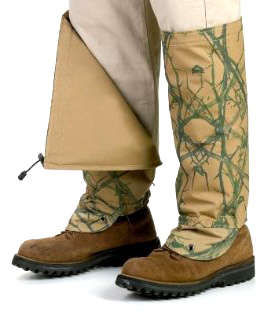 suggestions. Lately, many emails have been from women asking about snake proof boots. Here are a few examples of their comments: suggestions. Lately, many emails have been from women asking about snake proof boots. Here are a few examples of their comments:
“I am interested in a pair of snake proof boss for hiking. The ones on this site look like they would be uncomfortable for hiking. Thoughts?”
“Got any suggestions for tall, slender girls? I’ve tried on lots of boots where the calves are huge on me. And I wear a women's size 11. Thanks!”
“So all you have are snake proof boots for men? All of these boots are BUTT UGLY!!! How about a nice looking, rugged snakeproof boot for women?”
Our honest recommendation to our female customers is not to buy snake boots at all— snake gaiters for 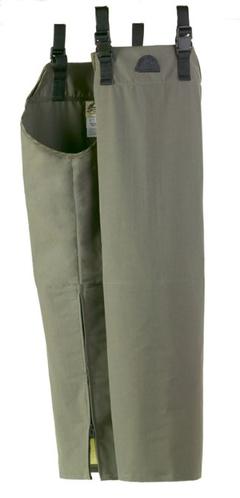 women, worn over pants and with your own hiking boots, are a far better option. Same goes for snake chaps if you need snake protection above the knee. Here’s why: women, worn over pants and with your own hiking boots, are a far better option. Same goes for snake chaps if you need snake protection above the knee. Here’s why:
Unfortunately, the major manufacturers of snake boots make them in men's sizes. Men are their target customers. And since there is no real sizing chart to convert men's to women's sizing, it is anyone’s guess what size a woman should buy. Snake gaiters or snake chaps, easily solve the problem because both are truly uni-sex is sizing. That being said, however, if you have access to a local store that stocks boots, you may have good luck by trying them on in person. But to avoid a lot of extra shipping costs associated with returns and exchanges, we do not suggest that women buy snake boots online. Male customers never seem to have this problem as their sizes are true and the fit is comfortable.
Another reason we suggest that women not bother with boots is because then you would be stuck wearing the same pair all the time, or would need to buy several pair with different tread or features. Depending on the weather and terrain, you may need a boot with aggressive tread for some hiking trails, but not so much for other outdoor activities in snake country such as when you are cleaning up your backyard landscaping. Snake gaiters or chaps allow women to wear their own comfortable, stylish hiking boots to match the terrain and circumstances. You can then switch boots as often as needed. Snake gaiters are available in several colors and go with any footwear!
Snake gaiters and snake chaps are a less expensive option than boots, too, and are available in a variety of sizes and colors and brands.. Just be sure to wear a thicker hiking boot with your gaiters or chaps. Snake fangs may penetrate tennis shoes or a light hiking shoe with mesh on top or sides, so avoid those styles. Also, when you choose gaiters or chaps, there is no guessing with the size. Measure the circumference of your calves while wearing the same pants you would normally wear out in the field, compare to the sizing charts on this website, and you can’t go wrong!
Sunday, August 20 2017
Rattlesnakes usually stay away from humans, but health officials say about 8,000 people are bitten by venomous snakes in the country every year. Snakes bites are most prevalent between April and October and are on a record pace this year, according to many poison control centers. It doesn’t seem to matter if you are on the East Coast or the West Coast, or down South— location doesn’t matter. Snakes are very temperature-dependent, so it’s more a matter of warm weather than a particular state or region. 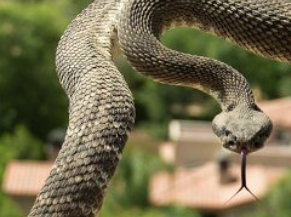
The number of calls last month to the Carolinas Poison Center about snake bites nearly quadrupled compared to last year. More than 500 calls about snake bites are expected in California. Georgia Poison Control reports a 50 percent increase in the number of bites reported this year compared to the same time period last year. This is a small sampling, but represents what most states are experiening in late summer.
A few species seem to cause the majority of poisonous bites: copperheads, cottonmouths (also called the water moccasin), eastern diamondback rattlesnakes, pigmy rattlesnakes, timber rattlesnakes, and sidewinders. It's true that there are ways to tell if a snake is venomous by its appearance, but most people aren't paying close enough attention to really know. It's better to assume ALL snakes are poisonous and avoid them. Don't be afraid to be outside, just be cautious and know what poisonous snakes look like that are common to the areas where you recreate and live. A rattlesnake, for example has a broad, triangular head. It has a relatively heavy or "fat" body, with a rattle on tail. The rattlesnake’s signature sound is a lot like bacon sizzling. However, these venomous creatures can lose their rattles over time, so don’t be lulled into a false sense of safety because you hear nothing. Even when not fatal, snake bites can be painful and scary. Bottom line: it's better to be safe than sorry, so follow these tips when in snake country no matter the state:
- Be alert. Like all reptiles, snakes are sensitive to the ambient temperature and will adjust their behavior accordingly. After a cold or cool night, they will attempt to raise their body temperature by basking in the sun midmorning. To prevent overheating during hot day, they will become more active at dawn, dusk or night.
- Wear sturdy boots or gaiters. Kid size snake chaps are worth considering, too. Never go barefoot or wear sandals when walking through brushy, wild areas. Startled snakes may not rattle before striking defensively. Children should not wear flip-flops while playing outdoors in snake country.
- When hiking, stick to well-used trails. Avoid tall grass, weeds and heavy underbrush where snakes may hide during the day. Never hike alone. Always have someone with you who can assist in an emergency.
- Do not step or put your hands where you cannot see. Step on logs and rocks, never over them, and be especially careful when climbing rocks or gathering firewood. Check out stumps or logs before sitting down, and shake out sleeping bags before use. Be careful when trimming tall weeds or working around wood piles even in your own backyard.
- Never grab “sticks” or “branches” while swimming in lakes and rivers. Rattlesnakes can swim! It’s not known why they take to the water, other than sometimes to escape predators.
- Teach children early to respect snakes and to leave them alone.
- Leash your dog when hiking in snake country so they can’t poke their noses into holes where a rattler might be hiding.
If you do get bitten, don’t try using an ice compress or a tourniquet. Don’t try “cutting and sucking.” Seek immediate medical attention and take comfort in the fact that the bites may cause intense, burning pain but are rarely fatal, unless it is a child or pet, in which case a bite can be deadly. Once at a hospital, treatment depends on the type of snake involved, the amount of venom injected and the health of the person bitten. If your dog is bitten, take it to the veterinarian immediately to receive the antivenin treatment.
Although snakes of any kind are not "out to get you," bites can and do occur. Your best defense is don't take a chance! Wear snake gaiters or snake pants when in known snake country - whether that be the desert or woods - and greatly reduce your chances of being bitten!
Sunday, June 04 2017
As the weather heats up, rattlesnakes especially become more active. They, like humans, tend to explore when the weather gets warm. Also like humans (those who enjoy the great outdoors, that is), rattlesnakes tend to avoid developed areas, preferring undisturbed, natural habitats. That means the more you hike, hunt, camp, fish, bike and recreate in wilderness areas, the greater your chances of encountering a pit viper. And another thing they have in common with humans is they tend to be found in log piles and rocks and other natural "seats" where you might be likely to enjoy your lunch or bask in the sun. They also can be found in swampy areas. Snakes are able to regulate their body temperature by moving in and out of shade. A warmer body allows a snake to move faster when trying to catch prey (insects, slugs, frogs, birds, bird eggs, small mammals, and other reptiles). 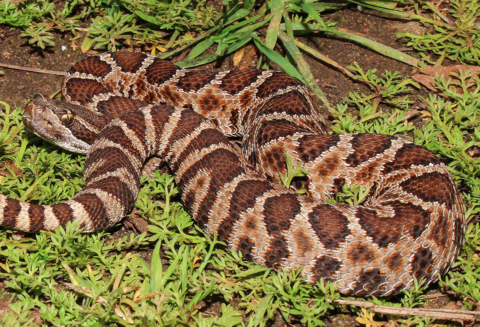
Rattlesnakes are native to North America, living in diverse habitats. There are 36 known species of rattlesnakes, with between 65 and 70 subspecies. The state with the most types of rattlesnakes are Texas and Arizona. Even baby rattlesnakes possess dangerous venom as soon as they hatch. Rattlesnakes all have the ability to rattle, hence their name, but they don't always make a rattling sound, so someone can be standing next to one and not even know it.
It is impossible to know what each and every variety of poisonous rattler looks like, but in general, they all have a triangular head, much wider than the neck, thick body with dull skin, and bands of color or splotches of color on backs and tail. Become familiar with the most common snakes found where you live or recreate. The three most common are:
Northern Pacific Rattlesnake: The color pattern is usually dark-brown, dark-gray, olive-brown, or sometimes black or pale yellowish ground color overlaid dorsally with a series of large, dark blotches with uneven white edges. These blotches are also wider than the spaces that separate them. Additionally, a lateral series of blotches, usually darker than the dorsal blotches, is clearly visible on all but the darkest specimens. The first rings of the tail are about the same color as the last body blotches, but these rings become progressively darker; the last two rings, at the base of the tail, are usually black. The belly is pale yellow, usually with brown spots. A large, dark-brown blotch on the snout has a pale border behind it. There is a dark brown postocular stripe with a white border that extends from the eye to around the angle of the jaw.
Western Diamond-Backed Rattlesnake: A large and heavy-bodied species, this rattlesnake's coloring varies from chalky gray to dull red, appearing dusty due to minute flecks and dots on the scales. As suggested by its common name, this species has diamond-shaped markings over most of its body, which are edged with black and white. These markings are replaced by conspicuous black and white bands towards the rear of the tail, just in front of the rattle, while the head has two characteristic pale stripes, one in front of the eye and the other behind, which run diagonally down the head towards the mouth.
Timber Rattlesnake: This is the only rattlesnake species in most of the populous northeastern United States; it is the third largest venomous snake in the United States.The physical color of a timber rattlesnake can vary widely depending on its area. Some are gray with a rich black pattern, some are tan with a sulfur yellow pattern, and some are a combination of both. They have V or W-shaped crossbar markings, which create a distinct pattern across its back. Generally they have a wide head and narrow necks. They have a distinctive rattler on its tail made up of a special scales. Their eyes are yellow, with elliptical pupils. These are large snakes, generally ranging from 36-60 inches (90-152 cm) in length and between 1.5 to 3 pounds.
It is estimated that 7,000 to 8,000 people are bitten by venomous snakes in the United States each year, resulting in many deaths. The most important factor in survival is the time elapsed between the bite and treatment. Most deaths occur between six and 48 hours after the bite. If antivenom treatment is given within two hours of the bite, the probability of recovery is greater than 99 percent. Still, any bite by a rattlesnake must be considered a life-threatening medical emergency!
When a bite occurs, the amount of venom injected is under voluntary control by the snake. The amount released depends on a variety of factors, including the condition of the snake (e.g. having long, healthy fangs and a full venom sack) and its temperament (an angry, hungry snake that has just been stepped on vs. a satiated snake that was merely surprised by walking near it). About 20% of bites result in no envenomation at all. Common symptoms include swelling, severe pain, tingling, weakness, anxiety, nausea and vomiting, hemorrhaging, perspiration, and eventually heart failure. Local pain is often intense, and will increase. Children generally experience more severe symptoms because they receive a larger amount of venom per unit of body mass.
What to do if bitten by a snake:
If bitten by a rattlesnake, stay calm and send someone to call 911. Always hike with a friend so you can help each other in case of emergency. The victim should remain calm by lying down with the affected limb lower than the heart. Do not waste precious time on tourniquets, "cutting and sucking," or snake bite kits. If you are by yourself, walk calmly to the nearest source of help: another person or a phone to Dial 911. Do Not Run. If you are not sure what kind of snake bit you, check the bite for two puncture marks (in rare cases one puncture mark) associated with intense, burning pain. This is typical of a rattle snake bite.
Although snakes of any kind are not "out to get you," bites can and do occur. Your best defense is don't take a chance! Wear snake gaiters or snake boots when in known snake country - whether that be the desert or woods - and greatly reduce your chances of being bitten!
Tuesday, May 02 2017
“Rattlesnake encounter in California State Park sends hiker to hospital”
“Elderly woman hospitalized after snake bite in Mobile”
“Rattlesnakes are coming out in Phoenix”
“Man flown to hospital after being bit by rattlesnake in Dallas”
“SC woman dies after rattlesnake bite at nature preserve”
“Rattlesnake bites boy who mistook it for a toy.”
 Headlines like these, while scary, serve a good purpose— to remind us to be alert and prepared while we’re in snake country. Worldwide, there are over 100,000 confirmed deaths from snakebites every year; the vast majority of those deaths do not occur in the United States. But when people here do get bitten, whether it’s by a rattler, cottonmouth, copperhead, coral snake, or other viper, it’s usually between the months of April and October. Headlines like these, while scary, serve a good purpose— to remind us to be alert and prepared while we’re in snake country. Worldwide, there are over 100,000 confirmed deaths from snakebites every year; the vast majority of those deaths do not occur in the United States. But when people here do get bitten, whether it’s by a rattler, cottonmouth, copperhead, coral snake, or other viper, it’s usually between the months of April and October.
Just about a quarter of all rattlesnake bites are “dry,” where no venom is injected. Other bites that do inject poisonous venom will definitely ruin your day, but not always kill you. The effects of being bitten are unpleasant to say the least. According to bite victims, your face starts tingling, your flesh feels like someone has sewn hot coals beneath your skin, your pulse flutters, and your limb puffs up like a water balloon. Not to mention the cost of being treated with anti-venom. Why even take that chance?
Overall, rattlesnakes are an important part of the ecosystem as they eat rodents and are eaten by other predators. They are generally shy creatures and will gladly retreat if given enough room, but their bites can be extremely dangerous, so knowing what to do to avoid them in the first place is key. The sound of rattling can instill cold fear in a hiker, but that's a good thing. You got the warning before accidentally stepping on or too close to a snake!
Despite the headlines, it’s possible to live and recreate safely around rattlers by taking precautions. The U.S. Fish and Wildlife Service recommends:
- Never go barefoot or wear sandals when walking through wild areas. Wear over-the-ankle hiking boots with snake gaiters, or wear snake proof boots. For full leg protection, consider snake chaps.
- When hiking, stick to well-used trails. Avoid tall grass, weeds and heavy underbrush where snakes may hide during the day.
- Do not step or put your hands where you cannot see and avoid wandering around in the dark. Step on logs and rocks, never over them, and be especially careful when climbing on rocks or gathering firewood.
- Check out stumps or logs before sitting down, and shake out sleeping bags before use.
- Never hike alone. Always have someone with you who can assist in an emergency.
- Teach children to respect snakes and to leave them alone. Children are naturally curious and will pick up snakes.
- Seek IMMEDIATE professional medical attention if bitten.
Monday, February 20 2017
Most posts on this blog are about protecting yourself from snake bite while outdoors— while hunting, hiking, clearing brush, or just walking your dog while in the desert or woods where snakes live. But what if you found a rattlesnake in your bathroom at home?!
Unfortunat ely, a family in Texas was recently taken by surprise when they discovered a live rattlesnake slithering in their toilet bowl! According to the family, the snake was pretty much alive and was doing its best to climb out of the toilet bowl. The family called in a snake removal company. Lucky they did that, not only for their own immediate safety, but because upon inspecting their house, the snake removal company found more than one stray snake. Unbeknownst to anyone, their cellar had become a rattlesnake den! ely, a family in Texas was recently taken by surprise when they discovered a live rattlesnake slithering in their toilet bowl! According to the family, the snake was pretty much alive and was doing its best to climb out of the toilet bowl. The family called in a snake removal company. Lucky they did that, not only for their own immediate safety, but because upon inspecting their house, the snake removal company found more than one stray snake. Unbeknownst to anyone, their cellar had become a rattlesnake den!
According to the company’s spokesperson, the snake removal team found more than 20 rattlesnakes in the family’s storm cellar. And, five of those snakes were infants. Rattlesnakes are extremely protective of their infants, but fortunately no injuries were reported by the family, and the large rattlesnake population was successfully relocated. As for the little creeper that exited through the family’s toilet, the experts believe that the snake somehow managed to enter a relief pipe and to make its way up. To ensure the family’s safety, the snake removal company sealed the relief pipe. After a clean sweep, no other rattlesnakes were found on the Texas family’s property.
Although the family claimed that they hadn’t seen a rattlesnake on their property for years, the company’s spokesperson declared that even though we can’t see them, snakes are still out there. Rattlesnakes and other poisonous vipers can be masters of disguise— relying on skin camouflage in order to elude bigger predators. That's how snakes can take up residence in your residence— if you don't hear a rattle, you don't necessarily know that they are there. Or they might be living in an area of your home or yard where you don't visit very often, such as a basement or outbuilding.
In addition to checking the rarely used areas of your home and property, your best defense against unwanted visitors is to make your property unattractive to snakes. Don't give them places to hide (abandoned junk piles and overgrown brush) and eliminate their food source such as mice and other small rodents. The neurotoxin carried by the snake’s venom can kill an adult in six hours or less. Even if not fatal, rattlesnake bite symptoms may include pain, tingling, swelling, numbness, nausea, weakness, and breathing issues— so don't take a chance! Whenever you are in snake country, protect yourself by wearing snake gaiters or snake boots and keep your eyes open to stay safe!
Tuesday, September 06 2016
Although kids heading back to school and the calendar tells us that summer is officially winding down, encounters with  snakes are not. Drought conditions, triple-digit temperatures, and other factors mean you still need to be very aware of the potential to see snakes, especially if you’re enjoying the outdoors in the late evening. snakes are not. Drought conditions, triple-digit temperatures, and other factors mean you still need to be very aware of the potential to see snakes, especially if you’re enjoying the outdoors in the late evening.
Snakes (pit vipers such as Copperheads, Cottonmouths, and Rattlesnakes are the most common) are not necessarily more active later in the day, you just might not see them as well now that the amount of sunlight each day is getting shorter, and the light is not as bright. When out in the evenings, carry a flashlight and watch where you put your hands and feet and watch where you sit down. And avoid walking close to bushes or crevices with large holes.
Reports of snake encounters have been particularly high in Texas and California this year. Texas is home to over 105 different species and subspecies of snakes; about 15 of those are potentially dangerous to humans. The Golden State is currently in the fifth year of a record drought. It seems that lack of rain results in an abundance of rattlesnakes. Rattlers are coming up from their outback burrows and wind up in backyards and parks. The California Fish and Wildlife Department. says in pre–drought years the populace averaged about 800 rattlesnake bites a year.
Medical experts advise that if you are among the 800 unlucky ones, forget everything you learned from old Western movies— no using a tourniquet, making an incision and trying to suck out the poison. A rattlesnake bite should be taken very seriously. Call 911 immediately! The faster you can get treatment, the better the outcome.The sooner you can get medical attention the sooner they can activate the system needed to get sufficient quantities of anti-venom to treat your bite. After that, the best but the hardest thing to do is try to remain calm. Avoid getting your heart rate up, which spreads the venom throughout your body faster.
The same advice goes for pets if they are bitten. "The sooner the animal gets treatment, the more than likely it's going to survive," said a veterinarian in El Paso, Texas. “There is an antivenin available, but it’s extremely expensive. The effectiveness depends of the size of the dog and the amount of venom injected by the snake. A dose of antivenin for pets can cost more than $1,000." The cost of Crofab— the human antivenin— in some cases can cost more than $10,000!
So no matter what the calendar might be telling us, keep in mind rattlesnakes are still in full force right now. They won’t go into hibernation in most areas for two or three more months. Whenever you’re out and about in snake country, or working in wooded areas or weeds, prevention is your best bet— wear snake gaiters or snake proof boots.
Sunday, July 17 2016
“The number of reported bites usually hovers in the double digits through May, June and July and then jumps to about 30 in August and September,” said an employee at the Arizona Poison and Drug Information Center. “It’s about a bite a day during those months before tapering off in October and November.”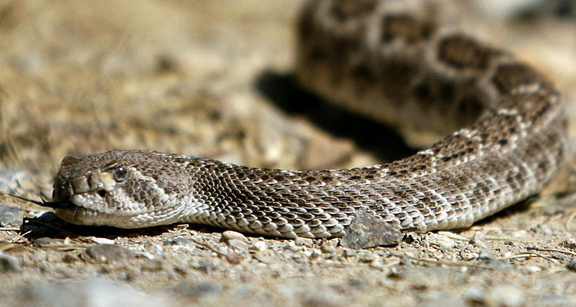
Yikes! A bite a day in just southern Arizona alone?! The Grand Canyon state is home to 13 species of rattlesnakes, with eight or nine species living in Southeastern Arizona, depending on how the region is defined, and on average, 150 to 160 rattlesnake bites are reported every year. Multiply those statistics by all the states where poisonous vipers live, and you know why you've got to be careful this summer!
Rattlesnakes typically come out of their winter dens in March or April, and return in November. They range far and wide — from deserts, canyons and forests to urban backyards. Some rattlers slither a mile or more from their dens to places where they spend the summer— many times in the same places where humans and dogs hike, camp, hunt and live. Some rattlesnake bites are so-called “dry bites” in which no venom is injected. Sometimes the dry-bite rate can be 20 percent. It all depends on the age of the snake, if it has recently eaten (and used its venom on the rodent it bit), and other factors.
“I’ve been a little bit paranoid just walking around the house now,” admits a home owner in Anaheim Hills, California who was hospitalized after she was bit in her own bathroom by a rattlesnake. Her neighbor’s Beagle was also bitten the week before by a baby rattlesnake. Both received anti-venom and are recovering. Fire officials say the appearance of rattlesnakes in Orange County is no rare occurrence. “The reason why we’re seeing more and more snake calls, and snake incidents, is because it’s so dry. It’s the fourth year of a serious drought, and it’s been so hot lately. These snakes are trying to find water.”
Rangers in Boulder County are warning hikers and cyclists to be on the lookout for snakes in the grass after a Wyoming resident who'd been visiting friends in Colorado was bitten on the shin by an adult snake that was about three feet long. The friends reportedly got off their bicycles and were crossing an open grassy area to go to a different trail when the woman was bitten. The victim was airlifted to a nearby hospital, treated with anti-venom, and was released.
"Contrary to many people's understanding, rattlesnakes do not deliberately harm people. They will only strike if threatened; otherwise, rattlesnakes will do everything possible to avoid a human encounter." Officials in Boulder caution people to watch where they step, particularly when in rocky or grassy open areas, and to be careful about what you wear. Especially this time of year the weather is beautiful and you want to wear shorts, but leaving one's legs bare and ankles exposed may not be wise for people who leave the traveled trails. Always keep your dogs on a short leash when hiking to minimize the opportunity for them to poke their nose where a prairie rattlesnake might be hiding.
Snake bite victims are generally not doing anything wrong. They are just in the wrong place at the wrong time— working in the yard or around a wood pile, or outside enjoying the summer— and nothing could have been done to prevent the bite. But if you are purposely going into known snake country to hike or hunt, the best prevention is to wear snake gaiters or snake proof boots.
If the worse happens, the best response to a bite is to go immediately to a medical facility for examination and treatment with anti-venom if needed. No cutting, no sucking, no tourniquets. Just get to a hospital. Other tips include not putting ice on the bite, and any limbs that are bit, whether it be on the arm or the leg, should be kept below the heart.
Friday, February 12 2016
It's only mid February, but high temperatures in many southwestern states, such as Arizona, are seeing an early spring warming trend, so now is a good time to remind everyone to beware of rattlesnakes! When snakes sense a litt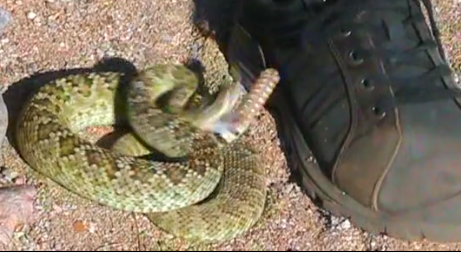 le bit of heat and humidity, they come out of hibernation, so now is the time they are becoming active again. Of course, no one sets out to encounter a snake, so the very best piece of advice is to be aware of your surroundings during rattlesnake season so you won't become a statistic. Two poison centers in Arizona alone treat an average 250-300 snake bite victims every year. The American Association of Poison Control Centers reported more than 750 rattlesnake bites in 2014 with 3 resulting in deaths. And that's just some of the stats. Minimize your chances of snake bite by following these tips: le bit of heat and humidity, they come out of hibernation, so now is the time they are becoming active again. Of course, no one sets out to encounter a snake, so the very best piece of advice is to be aware of your surroundings during rattlesnake season so you won't become a statistic. Two poison centers in Arizona alone treat an average 250-300 snake bite victims every year. The American Association of Poison Control Centers reported more than 750 rattlesnake bites in 2014 with 3 resulting in deaths. And that's just some of the stats. Minimize your chances of snake bite by following these tips:
- Wear closed-toe shoes. Sounds simple enough, but you'd be surprised at the number of sandal and flip-flop wearers on the trails. Above the ankle hiking boots and socks are even better - a lot of snake bites occur in the ankle area. Snake gaiters that cover from your ankle to your knee are your very best form of snake bite protection. And when hiking, don't just look straight down. Look ahead and to the side before you step. Although reptiles are most active during the months of April through October, during the hottest months they're most active at night. If it's dusk or dark outside, use a flashlight or headlamp to illuminate your path so you don't accidentally step on a snake.
- If you can't see it, don't stick your hand in it. This just doesn't apply to reaching under wood piles or into rock crevices, it also applies to golf. Don't stick your hand in a bush or a shrub for a wayward golf ball, as these areas are the perfect places for snakes to hang out. You don't want to startle one. Same theory applies if you're hiking or rock climbing or gardening. And remember, rattlesnakes can swim so look twice if you see a floating "stick" in the water!
- Don't underestimate a baby rattlesnake. There is no such thing as a cute rattlesnake. Baby rattlesnake venom is just as deadly as older snakes, and due to their smaller size, they can be harder to see and thus avoid. Younger rattlesnakes are born without a traditional rattle, so you can't always rely on the noise as a warning. Since rodents are a primary source of food for rattlesnakes, be sure to get rid of any rodents in your yard. Be careful with bird feeders too because those can attract rodents and snakes will be drawn to the smell of birds and rodents. Don't give those baby rattlers fuel for growing up!
- Practice proper trail etiquette. Experienced hikers know that there is an internationally accepted "triangle" of trail etiquette: Mountain bikers yield to runners, hikers and horses. Runners and hikers yield to horses. Horses are not required to yield to any group. But everyone and everything yields to snakes! Give them a wide berth if you spot one on the trail or even sunning itself on a rock. Don't try to kill or immobilize a snake. Save your pepper spray, too, because that won't work— just back away slowly and avoid a confrontation. If you are close enough to make a direct hit with the pepper spray, you’re close enough to get bit. Not a good place to be. And why aggravate a snake by spraying it anyway? Snakes don’t have eyelids, but they do have a transparent shield that protects their eyes, so the spray won’t really blind them. And while mammals are sensitive to the stuff in pepper spray, reptiles aren’t.
- Do not handle snakes even if you think they are dead. Believe it or not, some rattlesnakes can still strike and inject you with venom when they're dead. This is true even if the snake's head is cut off. Don't take a selfie or reach your hand out to touch it!
Snakes are always around, and with nicer weather, snakes and humans are becoming more active in the same environments so the potential for encounters increase. Unfortunately this can mean getting bitten while gardening, pulling weeds around your yard, walking to the mailbox, or hiking with your dog. There's a perception that most people are bit when they've been playing with or bothering a snake, but mostly it's acci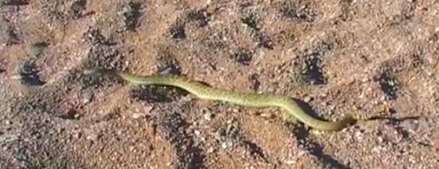 dental— being in the wrong place at the wrong time with a snake. dental— being in the wrong place at the wrong time with a snake.
Because the number of snake-bite reports increase as temperatures creep up, now is a good time of year to be reminded that being aware of your surroundings is the best thing you can do to stay safe in snake country. And if you frequently have a canine companion or two with you, consider a dog vest that protects them not only from snake bite, but from painful cactus needles, briars, and more.
Although you should be aware of the potential for a rattlesnake bite, don't be so worried you don't venture outdoors. Most people don't die as a result of a snake bite, as long as they get medical attention fast. The best thing you can do if bitten is to immobilize the wound and get to the hospital immediately. Most patients are out of the hospital in two days and then spend the next few weeks getting follow-up treatments. A typical person takes about a month to get "back to normal." Being bitten can cause severe injury and long-term complications, but being alert to the dangers of snakes and using snake bite protection can help you avoid them in the first place, and stay safe while in their territory.
|